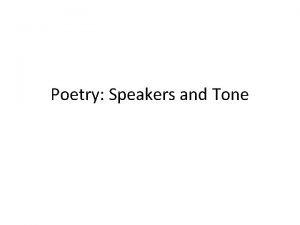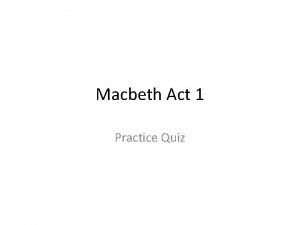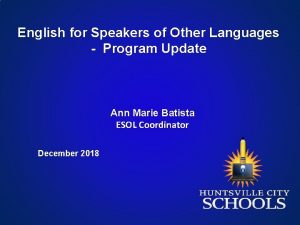TEACHING ENGLISH TO SPEAKERS OF OTHER LANGUAGES INTRODUCTION















- Slides: 15

TEACHING ENGLISH TO SPEAKERS OF OTHER LANGUAGES

INTRODUCTION Non-native English speakers come to a program of instruction with a wide variety of needs, problems and degrees of ability. • Some may not be literate in their mother tongue – while others are. • If they are literate in their mother tongue – it may not be a Roman alphabet. • Others may be able to read some English and may even have some understanding of English grammar. • They may have studied English before arriving in Canada but may not have conversational ability. • Others may be able speak English a little, but not read or write it.

CROSS-CULTURAL COMMUNICATIONS • While you are teaching a learner to communicate in a new language, you will be learning as well – a new culture. • Cross-cultural communication refers to all interaction between people of different cultures. • Non-verbal communication expresses just as much as verbal language does, if not more. • Cultural differences extend beyond language and nonverbal communication to perceptions and expectations. • Value your students’ cultural heritage and learn from them – learn from each other.

STUDENT NEEDS • Most learners looking for ESL support are seeking ‘survival’ language skills. • These skills will enable them to use the bank, post office, supermarket or to seek help from doctors or teachers. • Establish a reassuring and supportive environment – for many ESL learners you may be one of their first close contacts who speak English.

SECOND LANGUAGE ACQUISITION • Let students learn the names and labels of things even though they may not know the grammatical structures to use them properly. • Expect grammatical errors as part of the learning process. A student who makes an error is exploring language and will learn faster than the silent participant in the corner who is memorizing conjugations. • Provide ample listening experiences but do not expect learners to be able to reproduce everything they understand. • Provide a meaningful context for your learning activities, that takes into account the feelings and concerns of the learner.

LANGUAGE LEARNING PRINCIPLES • Students who have positive feelings about English and the people who speak English are more highly motivated to learn the language. • Set a tone of cheerful confidence in the session. • Students learn at different rates – language aptitude, age, personality, cultural and linguistic backgrounds all affect language-learning. • Teach language as it is really used. • Teach grammar as it is needed for successful communication. • Accented speech and some grammatical errors are inevitable and acceptable as long as learners can communicate effectively. • Language is best learned when it is incidental to some other task.

LISTENING SKILLS Three techniques to improve listening: • Total Physical Response • Listening for Specific Information • Dictation

SPEAKING SKILLS Techniques that strengthen speaking skills: • Pattern Drills • Dialogues • Role Play • Conversation Practice

SPEAKING TECHNIQUES • Pattern drills enable students to practice specific sentence patterns. Within these patterns they see how a variety of words can be used to send different messages. • A dialogue is an interaction between two people that could happen in your learner’s real world. Students find themselves in a common situation, receive a standard opener, and they are able to respond. • Role play is an extension of the dialogue practice. It has no memorized scripts. Students are given the setting and task but the dialogue is improvised. • Conversation practice is an extremely important part of language learning. Conversations and discussions cause students to use their emerging language ability to communicate their ideas.

BUILDING READING SKILLS Some tasks may include: • Finding a telephone number in the phone book • Locating an apartment in the classified section of the newspaper • Using a cookbook • Ordering from a restaurant menu • Buying food, drugs and clothing in a store • Understanding a child’s report card • Understanding bus schedules • Following road signs

BUILDING WRITING SKILLS To develop a sound writing program, the first step is to determine the writing needs of your learner. Your list of needs will probably include: • Completing forms – cheques, deposit slips, applications of various types • Addressing letters and packages • Sending a text or creating a Facebook post • Writing short notes or letters

IMPROVING PRONUNCIATION • Articulation – There are thousands of sounds that can be used in human speech, but each language uses only a limited portion of these sounds. • Sounds Sets – tent, stop, butter, mountain – in each of these words, the sounds around the ‘t’ cause the pronunciation to change. • Words and Word Parts – Sounds in English are grouped to form root words, prefixes and suffixes. The way word parts are pronounced often depends on the other sounds in the word. • Stress – every multisyllabic word in English has an accent stressing one syllable over the others. Therefore, if the stress is placed on the wrong syllable, it can make the word unintelligible. • Rhythm – There are two general rhythmic patterns used in the world’s languages: syllable timing and stress timing. • Intonation – the meaning of a sentence can be altered by changing the intonation pattern. Simple statements usually end with the voice rising then falling on the last word.

RESOURCES • Laubach Way to English – the teacher’s manuals are guides to enable you to cover the elements of English which your student has to learn. You will also be able to write a lesson from ‘scratch’ on a topic that is relevant to an immediate need your student may have. (click here for more info) • Life. Prints ESL for Adults – this is a four-level series that builds language acquisition skills in the context of every day life experiences. In addition to the print resources, there a number of downloadable resources. (click here for more info)

OTHER RESOURCES LLNB Affiliated Councils may have additional resources available such as: • Teaching Adults (An ESL Resource Book) • English No Problem • Grammar Wise • Road to Work • That’s Life • Picture Dictionaries You can learn more about them here.

ADDITIONAL ONLINE RESOURCES • https: //www. gamestolearnenglish. com • https: //www. teach-this. com/esl-games • https: //eslauthority. com/resources/esl-games/ • https: //www. edutopia. org/discussion/12 -fun-speaking-games-language-learners • https: //englishlive. ef. com/blog/language-lab/10 -tips-perfect-english-pronunciation/
 How to teach english to arabic speakers
How to teach english to arabic speakers Petal in other languages
Petal in other languages New zealand official languages english
New zealand official languages english New zealand official languages english
New zealand official languages english Currents and magnets summarizer
Currents and magnets summarizer Agora speakers international
Agora speakers international Ipsip
Ipsip The speaker of a poem
The speaker of a poem Tone examples
Tone examples Kaitlyn pacheco
Kaitlyn pacheco Nnnn speakers
Nnnn speakers Soundblock coaxial speakers creative commons pictures
Soundblock coaxial speakers creative commons pictures Sons kinsmen thanes
Sons kinsmen thanes Dear honorable guests
Dear honorable guests Agora speakers
Agora speakers Speakers
Speakers





























